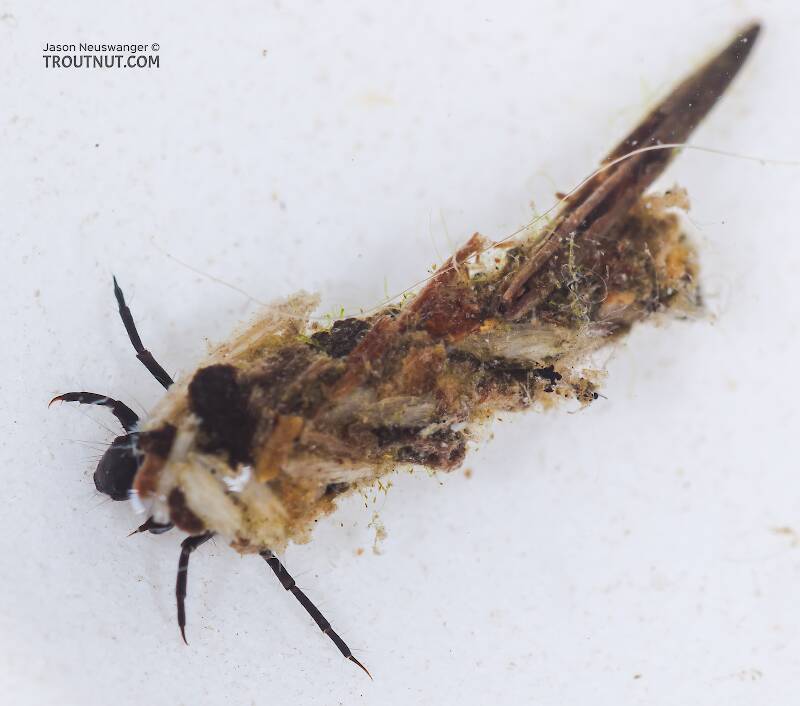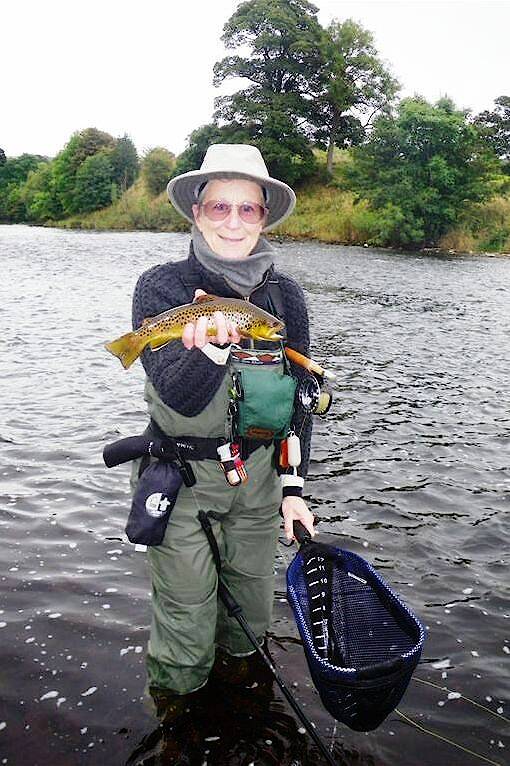
Hex Mayflies
Hexagenia limbata
The famous nocturnal Hex hatch of the Midwest (and a few other lucky locations) stirs to the surface mythically large brown trout that only touch streamers for the rest of the year.
Featured on the forum

This seems to be a young larva of Limnephilus. Although not clear in the picture, several ventral abdominal segments have chloride epithelia.

Troutnut is a project started in 2003 by salmonid ecologist Jason "Troutnut" Neuswanger to help anglers and
fly tyers unabashedly embrace the entomological side of the sport. Learn more about Troutnut or
support the project for an enhanced experience here.
RleeP on May 8, 2007May 8th, 2007, 9:44 am EDT
I'll apologize at the outset for putting this post here when it may actually belong in the fly tying section. I'm hoping for some responses sooner rather than later and this is the forum with the most traffic, or so it seems at any rate.
Briefly, I'm interested in experiences/patterns from the group here relating to tying for and fishing the periodic (17 year, 13 year) cicada.
It looks like the better part of SW Wisconsin and NE Iowa where I do most of my fishing these days will be hosting these things in their usual profusion shortly.
I've looked around online and none of the patterns I've found (I've found darn few actually that aren't from New Zealand where the cicada is evidently the national insect..) do much for me or my generally utilitarian sense of tying. This same sense tells me that I'd probably be OK just tying a bunch of oversized 'hopper-style flies with black bodies. But I've not fished through an event of these things and wanted to tap the assembled wisdom here as to your thinking and pattern suggestions.
Here, allegedly is the bug in question:
http://betterlawns.com/images/cicadas.jpg
Regards,
Lee
Briefly, I'm interested in experiences/patterns from the group here relating to tying for and fishing the periodic (17 year, 13 year) cicada.
It looks like the better part of SW Wisconsin and NE Iowa where I do most of my fishing these days will be hosting these things in their usual profusion shortly.
I've looked around online and none of the patterns I've found (I've found darn few actually that aren't from New Zealand where the cicada is evidently the national insect..) do much for me or my generally utilitarian sense of tying. This same sense tells me that I'd probably be OK just tying a bunch of oversized 'hopper-style flies with black bodies. But I've not fished through an event of these things and wanted to tap the assembled wisdom here as to your thinking and pattern suggestions.
Here, allegedly is the bug in question:
http://betterlawns.com/images/cicadas.jpg
Regards,
Lee
CaseyP on May 8, 2007May 8th, 2007, 1:55 pm EDT
two years ago, in South Central PA, i watched a cicada blunder onto and then escape the water. two smallish stockies tracked it with great interest, but neither worked up the courage to bite before the gigantic bug took off. maybe its swift progress across the pond suggested drag. or maybe it means you'll only catch bigger trout with your facsimile! as far as i could make out, the fish saw something black with prominent transparent wings and big legs. how about a big black Letort cricket? maybe the wings could be white Antron; i'd recommend deer hair legs.
BTW, if you scroll down past the different forum sections on the forum front page, you'll see the most recently posted topics arranged by time, so you catch all the latest whatever it is. on thread pages they're arranged on the left of the white bit in the middle of the screen.
BTW, if you scroll down past the different forum sections on the forum front page, you'll see the most recently posted topics arranged by time, so you catch all the latest whatever it is. on thread pages they're arranged on the left of the white bit in the middle of the screen.
"You can observe a lot by watching." Yogi Berra
Shawnny3 on May 8, 2007May 8th, 2007, 2:14 pm EDT
Ah, yes. We had a brood hatch here a few years ago, and I developed a few variations. Alas, they didn't appear heavily in my immediate area, and I ended up with a flybox full of big ol' bugs 17 years from their next potential use. Rather than waste them, I tried them on largemouth bass with half-decent results.
I assume you don't want to get into the business of making foam lures, for which I applaud you. My ties are made with deer or elk hair. I came up with them before I read anything by Chauncey Lively, but I'm flattered when people compare these ties to his, since he was a genius at developing innovative and practical flies with natural materials. Here's my process:
When most people use deer or elk hair for a large fly they spin it and trim it to shape. I have found a less time-consuming way of getting all that hair on the hook and achieving what I think is a better effect.
The pattern uses a variation of a technique I learned for tying grasshopper and beetle bodies. It involves tying in a large tuft of hair in one place, then wrapping the thread forward (on the hook, not over the hair), and binding down the same tuft in a different place, and so on, thus binding the hair lengthwise on the hook in segments. Doubling hair back on itself can be an effective way of adding bulk, but I've found it is easiest to just make sure that the first tuft you tie in is thick enough at the tie-in point to account for the entire girth of the cicada (obviously, this large clump should be tied in several, smaller clumps at the same tie-in point). Tying in this much hair at one point calms down the splaying effect that occurs when tying hair directly on the hook shank. When the body is tied this way, mounting wings without having them splaying everywhere (as occurs with spun bodies) is easy. Legs can be made quite easily by picking out some strands of hair anywhere you want them. If you want a flatter profile, tie in a toothpick on either side of the hook before you do anything else (this will also help keep the body from riding around the hook). I've tied these in two ways:
1) (The hard way) Tie the entire fly using the above technique, resulting in a strikingly realistic segmented body. By using burnt orange hair and black thread, you can achieve the band pattern on the naturals. If the orange is too bright, use a brown permanent marker to make it more subtle when finished with the tying. The trouble with doing the entire fly this way is that it is very time-consuming, even after you've gotten the hang of it. But the fly looks awesome, even if the fish couldn't care less.
2) (The easy way) Tie in the original tuft of hair just forward of the middle of the hook, leaving the hair long enough toward the front to finish the fly with the technique described above, and leaving the rest of the length of hair shooting out off the back of the hook. Tie in some black bucktail (not deer hair) on the top (sparsely) for a wing (leave it long in front and just tie it in with everything else in the next step). Tie the front of the fly by binding the tuft in one or two segments to form the thorax and head. Then just tie off the fly and trim the excess hair sticking out over the eye (not too cleanly, though - leave it a little scraggly). Now deal with the huge tuft sticking off the back of the fly, which will become the abdomen with some trimming: Trim it to the proper shape, leaving a few strands of burnt orange on the top untrimmed to accent the black in the wing. Trim the wing to shape, marker the trimmed abdomen, thorax, and head with brown and black if you want, and you're done. This method is far faster than spinning the entire body and achieves (I think) a more natural silouette. It also makes tying in a wing simple. I think that this may be a technique easily applied to hoppers or other surface flies as well.
How do I post pictures, Jason? (Sorry, I know you've gone over this many times...)
-Shawn
I assume you don't want to get into the business of making foam lures, for which I applaud you. My ties are made with deer or elk hair. I came up with them before I read anything by Chauncey Lively, but I'm flattered when people compare these ties to his, since he was a genius at developing innovative and practical flies with natural materials. Here's my process:
When most people use deer or elk hair for a large fly they spin it and trim it to shape. I have found a less time-consuming way of getting all that hair on the hook and achieving what I think is a better effect.
The pattern uses a variation of a technique I learned for tying grasshopper and beetle bodies. It involves tying in a large tuft of hair in one place, then wrapping the thread forward (on the hook, not over the hair), and binding down the same tuft in a different place, and so on, thus binding the hair lengthwise on the hook in segments. Doubling hair back on itself can be an effective way of adding bulk, but I've found it is easiest to just make sure that the first tuft you tie in is thick enough at the tie-in point to account for the entire girth of the cicada (obviously, this large clump should be tied in several, smaller clumps at the same tie-in point). Tying in this much hair at one point calms down the splaying effect that occurs when tying hair directly on the hook shank. When the body is tied this way, mounting wings without having them splaying everywhere (as occurs with spun bodies) is easy. Legs can be made quite easily by picking out some strands of hair anywhere you want them. If you want a flatter profile, tie in a toothpick on either side of the hook before you do anything else (this will also help keep the body from riding around the hook). I've tied these in two ways:
1) (The hard way) Tie the entire fly using the above technique, resulting in a strikingly realistic segmented body. By using burnt orange hair and black thread, you can achieve the band pattern on the naturals. If the orange is too bright, use a brown permanent marker to make it more subtle when finished with the tying. The trouble with doing the entire fly this way is that it is very time-consuming, even after you've gotten the hang of it. But the fly looks awesome, even if the fish couldn't care less.
2) (The easy way) Tie in the original tuft of hair just forward of the middle of the hook, leaving the hair long enough toward the front to finish the fly with the technique described above, and leaving the rest of the length of hair shooting out off the back of the hook. Tie in some black bucktail (not deer hair) on the top (sparsely) for a wing (leave it long in front and just tie it in with everything else in the next step). Tie the front of the fly by binding the tuft in one or two segments to form the thorax and head. Then just tie off the fly and trim the excess hair sticking out over the eye (not too cleanly, though - leave it a little scraggly). Now deal with the huge tuft sticking off the back of the fly, which will become the abdomen with some trimming: Trim it to the proper shape, leaving a few strands of burnt orange on the top untrimmed to accent the black in the wing. Trim the wing to shape, marker the trimmed abdomen, thorax, and head with brown and black if you want, and you're done. This method is far faster than spinning the entire body and achieves (I think) a more natural silouette. It also makes tying in a wing simple. I think that this may be a technique easily applied to hoppers or other surface flies as well.
How do I post pictures, Jason? (Sorry, I know you've gone over this many times...)
-Shawn
Jewelry-Quality Artistic Salmon Flies, by Shawn Davis
www.davisflydesigns.com
www.davisflydesigns.com
Shawnny3 on May 8, 2007May 8th, 2007, 3:53 pm EDT
Jason, I just noticed that I should add pics in the Photography forum. Now, I just have to figure out how to shrink the image sizes so they will upload. I'll get my wife to help me with it tomorrow.
Thanks,
Shawn
Thanks,
Shawn
Jewelry-Quality Artistic Salmon Flies, by Shawn Davis
www.davisflydesigns.com
www.davisflydesigns.com
RleeP on May 9, 2007May 9th, 2007, 10:39 am EDT
Thank You, Casey and Shawn.
That's an interesting technique, Shawn...
I think I'll suspend my usual self-imposed rule of never tying a fly that takes more than 15 minutes or of sufficient complexity that I begin to experience some emotional investment (Even though I've been tying since LBJ's first anniversary in the White House, I'm still a 10-thumbed tier) , and I'll give that a try..:)
Thanks again,
Lee
That's an interesting technique, Shawn...
I think I'll suspend my usual self-imposed rule of never tying a fly that takes more than 15 minutes or of sufficient complexity that I begin to experience some emotional investment (Even though I've been tying since LBJ's first anniversary in the White House, I'm still a 10-thumbed tier) , and I'll give that a try..:)
Thanks again,
Lee
Shawnny3 on May 10, 2007May 10th, 2007, 1:13 pm EDT
Whew! Finally got those pics posted in the Photography section: http://www.troutnut.com/topic/691
The tying time on the second fly shouldn't be more than 10-15 minutes. Remember, it's supposed to be ugly. But it does take a little time getting that much hair on a hook.
-Shawn
The tying time on the second fly shouldn't be more than 10-15 minutes. Remember, it's supposed to be ugly. But it does take a little time getting that much hair on a hook.
-Shawn
Jewelry-Quality Artistic Salmon Flies, by Shawn Davis
www.davisflydesigns.com
www.davisflydesigns.com
Marshall on Sep 12, 2007September 12th, 2007, 8:55 am EDT
Lee,
My son Pete Tackett designs flies and has a beautiful cicada that works everytime he throws it.
You can get in touch with him at Fishermn226@aol.com
My son Pete Tackett designs flies and has a beautiful cicada that works everytime he throws it.
You can get in touch with him at Fishermn226@aol.com
Marshall
Davez on Sep 13, 2007September 13th, 2007, 4:20 am EDT
i use an absolutely ugly, easy tie, because ive broken off some monster smallmouth, channel cats and carp on cicadas on the yough a few years ago.
its a ridiculous tie.
#2 streamer hook, krystal flash wing, orange G thread or orange backing, actually. 1/2" foam plug. not fancy, no eyes, tails, or other useless features.
its tied like an enormous caddis. its too ugly to post a pic. (embarrasing actually)
whats i've found off the shelf that worked is a Betts balsa popper in all black.
its a ridiculous tie.
#2 streamer hook, krystal flash wing, orange G thread or orange backing, actually. 1/2" foam plug. not fancy, no eyes, tails, or other useless features.
its tied like an enormous caddis. its too ugly to post a pic. (embarrasing actually)
whats i've found off the shelf that worked is a Betts balsa popper in all black.
Quick Reply
Related Discussions
Topic
Replies
Last Reply
Re: Three Trouble Makers at the Midwest Fly Fishing Expo the past weekend

In the Photography Board by Oldredbarn

In the Photography Board by Oldredbarn
3
Mar 11, 2014
by TNEAL
by TNEAL



